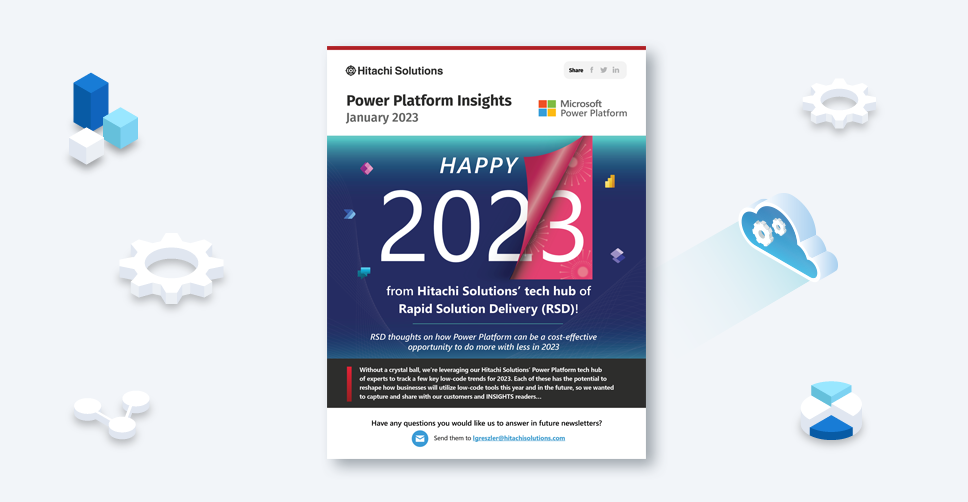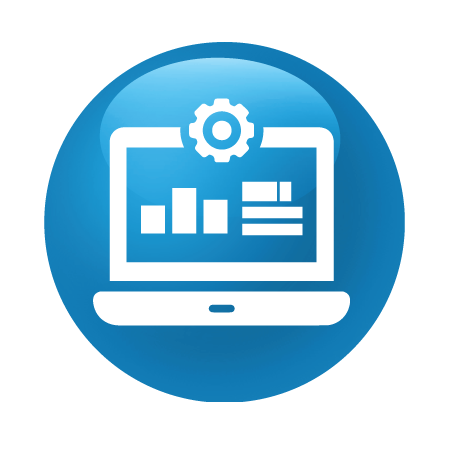

Power Platform Insights: January 2023
Learn how to do more with less in 2023 with our monthly edition of Power Platform Insights
Download the NewsletterHappy 2023 from Hitachi Solutions’ tech hub of Rapid Solution Deliver (RSD)! Without a crystal ball, we’re leveraging our Hitachi Solutions’ Power Platform tech hub of experts to track a few key low-code trends for 2023. Each of these has the potential to reshape how businesses will utilize low-code tools this year and in the future, so we wanted to capture and share with our customers and INSIGHTS readers…

Section 1: Platform Maturity
In the past two years, we’ve seen the Power Platform evolve from primarily a citizen developer
toolset to a more broadly used development platform with the onset of fusion — low-code and
pro-code developers working to build solutions. The following trends will further push the platform
in this direction:
ALM for all
Sometimes citizen-developed applications become popular, which can be problematic if the citizen
developer is not using good Application Lifecycle Management (ALM) practices—not managing
source code and developing in production environments. Microsoft is democratizing ALM by
making it central to Power Apps.
With Power Platform Pipelines (currently in preview), admins can create CI/CD pipelines and
makers can leverage these pipelines directly from within the maker experience. Running the pipeline
is easier for the makers than the traditional application and flow export process, and admins can use
this is to enforce code checks, run the solution checker, and set connections to pre-approved
service accounts.
Managed environments
Introduced in late 2022, managed environments give organizations an easier way to administer
capacity and usage of the Power Platform, and provide additional capabilities to control how apps
developed in managed environments can be shared with other employees.
Managed environments are premium environments, meaning everyone who owns an app or flow
in the environment must have a premium license (not just a Microsoft 365 license). So this limits
their usage today primarily to enterprise customers and environments not used for productivity
(such as the default environment).
But as Microsoft continues to add benefits to managed environments, we think its appeal will
grow. For example, the Power Platform pipelines feature mentioned earlier in this article is only
available in managed environments.
Our Recommendation
It’s not all or nothing. You can have both managed and unmanaged environments.
Environments used for important, or business-critical applications and automation
should be managed, while the personal productivity environments unmanaged (to
balanced license costs).
Power BI unifies with the Power Platform
While Power BI is considered part of the Power Platform, to date it has been more like a first cousin once removed.
Power BI is managed differently and has workspaces rather than environments. When moving Power Apps with Power BI, there has not been a unified process.
This changes with the introduction of Power BI in Power Apps solutions:
Now development teams building Power Apps solutions that include Power BI reports can add these
reports and datasets to their solutions. When the solution is moved to another environment, the workspace will be automatically provisioned.
Connections for the Power BI dataset can be managed as environment variables and the source
code for the Power BI reports can be managed along with the apps and flows.
We predict this will lead to an increased usage of Power BI in Power Platform solutions, and also
make it easier for ISVs and companies who sell software solutions based on the Power Platform to
include more visual analytics in their solutions.
Power House?
Mary Jo Foley reports that Microsoft is seeking to expand Power Platform beyond an IT platform by
introducing more pre-built industry-focused applications built on the Power Platform: Microsoft’s plan to turn its Power Platform into a ‘Power House’
While additional information on this initiative is unavailable at the moment, it makes sense, as
businesses buy solutions, not platforms. This also aligns with Hitachi Solutions’ industry vertical
strategy and many of our solutions for retail, manufacturing, healthcare, and insurance are built on
the Microsoft Power Platform.
Where is this going?
Each of these items paint a cohesive picture of a platform growing up. While still retaining its
youthful appeal for citizen developers with a low cost of entry, it is becoming more mature in the
ability to manage it, use source code, and many of the current sources of friction (such as managing
solutions with Power BI reports and the complexity of using pipelines with citizen developers) are
being re-imagined and improved. The result will be a platform that more enterprise organizations
(and ISVs) will be comfortable using to deliver their solutions.

Section 2: AI Infusion
Chances are many of your employees were distracted for part of the month of December as they were playing with the amazing ChatGPT. While we don’t expect Microsoft to introduce its own ChatGPT any time soon, AI is already (and will continue to) infusing the Power Platform.
One of the most exciting new capabilities (leveraging open AI) is Power Automate co-pilot:
New ways to innovate with AI and Microsoft Power Automate
With co-pilot, a maker simply describes the flow they want, and Power Automate builds the flow using AI.
In conjunction, AI builder continues to improve, now with support for unstructured documents. The ability to use unstructured documents in AI Builder is a gamechanger because it allows organizations to extract valuable insights and information from large amounts of unstructured data, which can be difficult or time-consuming to analyze manually. With AI Builder, organizations can quickly and easily build custom models that can analyze and interpret unstructured documents, such as emails, PDFs, and other types of documents. This can help organizations to make better-informed decisions, improve efficiency and reduce the time and resources required to process large volumes of unstructured data.
Compared to traditional OCR where you have to train a bot to look for specific areas of documents, this is a major improvement.

Section 3: Hyperautomation
One of our biggest surprises from 2022 was the traction Microsoft made in the RPA market. Keep
in mind that Microsoft’s foray into RPA is still fairly new, but with a very mature feature set (and an
extremely disruptive price point), Microsoft is gaining market share in automation.
The real value for customers of Microsoft’s offering is that it is the only vendor that is positioned to
deliver the full value of hyper-automation.
True hyperautomation combines AI, cloud, RPA, and analytics to automate at scale. Most of the
traditional automation platforms are primarily RPA (Robotic Process Automation) and RPA, by
definition, always carries some level of technical debt. While it can be a good short-term solution, it
can also be fragile as it is closely dependent on the UI of the applications automated. If those legacy
systems are updated, the automation can break.
We expect the trend to continue and accelerate in 2023 as more companies question their high
renewal costs for legacy automation platforms. Microsoft is well-positioned to replace these
platforms. Our recommendation is to think long-term—don’t just seek to replace your RPA platform
and stop there, look at how your business has evolved and how your automation should be
modernized to support your future growth.

Section 4: How Power Platform Works for Customers During Uncertain Economic Times
Will there be a recession in 2023? Nobody knows for sure how things are going to be in 2023, but
it’s fair to say that many budgets are not seeing the same kind of increases they realized in previous
years.
Low code development tools like the Microsoft Power Platform can help you do more with
less—they can frequently replace much more expensive systems (see the previous section about
replacing traditional expensive automation platforms with Power Automate) and enable you to build
applications, chatbots, and automations without having to hire new developers.
Hitachi Solutions can help — we would love to show you how you can use Power Platform to solve business challenges, cut your costs, and up-skill your makers to be more effective
Why Hitachi Solutions?
Hitachi Solutions helps its customers successfully compete with the largest global enterprises using powerful, easy-to-use, and affordable industry solutions built on Microsoft cloud services.


